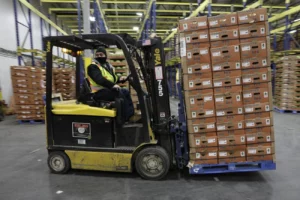Warehouse health and safety should be a top priority for any business with warehouse operations. Warehouses can present a range of unique health and safety hazards that require proper risk management. This guide from PALLITE provides an overview of key regulations, risks, and best practices for managing health and safety in warehouses to help protect your workers.
Why Warehouse Health and Safety Matters
Warehouses are busy environments with heavy machinery, moving vehicles, work at height, and manual handling that all pose serious potential risks to workers. Health and safety in warehouses is critical because:
- Workplace injuries are common in warehouses if risks are not properly controlled. Slips, trips, falls, strikes by objects, and musculoskeletal injuries from manual handling are some of the most common warehouse injuries.
- Not following health and safety regulations can lead to financial penalties, prosecutions, or even warehouse closures by regulatory authorities.
- Effective health and safety controls help minimise worker injuries and illnesses, reducing lost time and workers compensation costs.
- Promoting a culture of health and safety demonstrates you value your workforce and improves productivity and morale.
By making warehouse health and safety a priority and implementing best practices around hazard control, companies can create a safer, more compliant and productive warehouse environment.
Key Warehouse Health and Safety Regulations
There are a number of key regulations relating to warehouse health and safety that employers need to be aware of:
Health and Safety at Work Act 1974
This act places a general duty on employers to ensure the health, safety and welfare of employees and others who may be affected by their business activities.
Management of Health and Safety at Work Regulations 1999
These regulations require employers to carry out risk assessments, implement control measures, provide training, and manage health and safety effectively.
Manual Handling Operations Regulations 1992
These regulations require employers to avoid hazardous manual handling where reasonably practicable, conduct risk assessments for necessary manual handling, and implement controls to reduce the risk of injury.
Work at Height Regulations 2005
These regulations require employers to avoid work at height where possible or otherwise implement measures to prevent falls. This includes using the right equipment, conducting risk assessments, and providing training.
Control of Substances Hazardous to Health Regulations 2002
These regulations require employers to assess the risks from hazardous substances and take measures to prevent or control exposure. Safety data sheets must be provided.
Provision and Use of Work Equipment Regulations 1998
These regulations require work equipment provided for use at work, including machinery, to be safe and properly maintained.
Following these regulations is essential for any warehouse to avoid enforcement action. It also promotes a strong safety culture that helps protect workers.

11 Key Warehouse Health and Safety Risks
Warehouses contain a range of potential hazards that require dedicated safety management and control measures. Some of the main risks include:
1. Manual Handling Injuries
Manual handling covers any activity involving lifting, carrying, pushing, pulling, holding, moving, or restraining an object or person. It’s one of the biggest causes of workplace injury if not properly controlled. Common manual handling injuries in warehouses include back injuries, sprains, and strains.
Employers must avoid the need for hazardous manual handling as far as reasonably practicable. Where manual handling is necessary, risk assessments should be carried out and control measures implemented, such as:
- Using lifting aids and trolleys to reduce carrying distances and weights
- Providing manual handling equipment like pallet trucks
- Implementing safe lifting techniques through training
- Setting safe weight limits for manual handling
- Providing personal protective equipment like gloves
Regular training and safety supervision are key to minimising unsafe manual handling activities.
2. Slips, Trips and Falls
Slips, trips and falls are some of the most common warehouse incidents. They can be caused by spilled materials or liquids, cluttered walkways, uneven surfaces, poor lighting, loose flooring, lacking handrails on stairs, etc.
To reduce risks:
- Keep walkways free from obstructions and spills
- Provide adequate lighting, install mirrors at blind corners
- Repair any damaged flooring or stairs promptly
- Use high friction floor coatings like slip-resistant paint
- Ensure leakage from pallets or containers is cleaned up quickly
- Provide drip trays to contain leaks
- Use ‘wet floor’ warning signs
- Encourage proper footwear and avoid rushing
Regular warehouse inspection and maintenance is key to identifying and correcting slip and trip hazards.
3. Working at Height
Falls from height are a major risk for those working on mezzanine floors, using ladders, accessing high racking or loading bays. Falls can occur when equipment fails or during access, egress, or working at height.
Control measures should include:
- Installing guardrails and toe boards on elevated work areas
- Providing proper ladders or mobile elevated work platforms
- Ensuring all work at height follows a safe system of work
- Securing and maintaining storage racking
- Providing appropriate fall arrest systems and training where needed
- Conducting thorough risk assessment for working at height and ladder safety
4. Vehicle Movement Hazards
Warehouse workers face hazards from both internal vehicles like forklifts as well as external vehicles loading/unloading. Collisions can cause major crush injuries or death, with forklifts alone accounting for over 34,000 serious injuries every year.
Recommended controls include:
- Separating pedestrian walkways from vehicle areas
- Installing physical barriers between vehicles and pedestrians
- Providing mirrors and warning signals on vehicles and at blind corners
- Ensuring high visibility clothing is worn by pedestrians
- Limiting vehicle speeds and setting traffic rules
- Training workers on safe vehicle practices
- Load and Unload vehicles using the proper equipment
Regular maintenance and inspection of vehicles along with enforcement of traffic rules are key to preventing vehicle incidents.
5. Fire and Explosion
Warehouses contain significant risk of fire due to combustible materials, electrical faults, and flammable substances. Fires can lead to explosions, chemical releases, structural collapse and serious injuries.
Fire risks can be minimised by:
- Prohibiting smoking in or around warehouse
- Storing flammables properly in suitable containers
- Providing adequate fire detection and suppression equipment
- Installing and maintaining electrical systems safely
- Proper control of ignition sources like hot works
- Keeping fire exits and routes clear at all times
- Regular evacuation drills and emergency planning
A hot work permit system should strictly control any spark producing activities like welding. Ensure you have a robust fire safety protocol and training in place.
6. Collisions with Storage Racking, Goods, or Equipment
Warehouse workers can easily be struck by falling stock or unstable storage systems like pallet racking. Collision with forklifts, conveyors, and other mobile equipment is also a hazard.
Recommended controls:
- Use racking systems designed for warehouse use with proper loading capacity
- Secure pallet racking to the floor to prevent toppling
- Inspect racking regularly and after any impacts or damage
- Train workers to load racking correctly and safely
- Keep racking free of damage and implement reporting procedures for any issues identified
- Prevent unauthorised access to storage racking areas
- Provide forklift mirrors, alarms, seatbelts and flashing lights
- Enforce safe traffic rules like speed limits, right of way and walkways
PALLITE manufacture a series of lightweight yet robust warehouse storage systems made from honeycomb paper. To see how these could improve your warehouse layout and increase overall safety by removing hazards that would be otherwise stored poorly, speak to our team today or check out our PIX range now.
7. Ergonomic Injuries
Repetitive movements, awkward postures, and working on congested workstations can lead to ergonomic injuries over time including to the muscles, joints and tendons. Common issues include back pain and upper limb disorders.
Solutions include:
- Conducting workstation and work process risk assessments
- Implementing job rotation and adequate rest breaks
- Avoiding static postures and repeated movements
- Providing suitable furnishings like anti-fatigue matting
- Positioning items within easy reach
- Providing mechanical aids like trolleys to avoid carrying
- Adjustable chairs, monitors, and equipment
- Providing ergonomics training and reporting procedures
Early reporting of symptoms can help identify problem tasks and implement controls before serious injury occurs.
8. Chemical and Hazardous Substance Exposures
Warehouses may contain hazardous substances that can harm worker health through inhalation, ingestion, skin contact or absorption. Chemicals may also react to cause fires or explosions.
Key controls include:
- Identifying all hazardous substances on site through an inventory
- Conducting risk assessments and implementing controls for safe handling
- Safely storing chemicals as per safety data sheet requirements
- Providing proper ventilation and enclosures
- Ensuring emergency provisions like eye wash stations are accessible
- Using protective equipment like gloves, respirators, face shields
- Providing training on safe chemical handling and health risks
Suitable personal protective equipment (PPE) should be identified via risk assessment and provided to workers at no cost.
9. Noise Exposure
Prolonged loud noise in warehouses from equipment like forklifts can cause permanent hearing damage over time. Solutions involve:
- Conducting noise monitoring to identify problem areas
- Implementing engineering controls like noise damping and equipment isolation
- Providing suitable hearing protection and enforcing use
- Limiting time workers spend around loud noise
- Regular hearing tests to identify any early issues
- Training on noise risks and how to use hearing protection properly
Areas over 85dB require mandatory hearing protection along with noise monitoring and controls.
10. Fatigue
Warehouse operations involve physically demanding, repetitive work that can lead to injuries if workers are fatigued. Contributing factors include shift work, long hours, insufficient breaks and improper workplace design.
Fatigue can be minimised by:
- Regularly rotating workers between different tasks
- Providing adequate rest breaks and quarters
- Avoiding excessive overtime
- Designing work tasks to avoid monotony
- Ensuring adequate staffing levels
Fatigue management should be incorporated into the warehouse safety program.
11. Electrical Hazards
Poor electrical safety is a major cause of workplace fatalities. Hazards include electrocution from faulty equipment, exposed wires, water near electrical systems, lack of Out Of Service lockout procedures, etc.
Solutions include:
- Regular inspection and testing of electrical equipment
- Prompt repairs by qualified technicians
- Providing proper equipment guards and enclosures
- Waterproofing electrical systems in wash down areas
- Lockout tagout procedures for all service work
- Banning in-house electrical work on live systems
- Working with competent electrical contractors
Any contractor work should be audited to ensure proper safety procedures are followed.

Implementing Effective Warehouse Health and Safety Practices
Managing the diverse range of warehouse risks requires an integrated health and safety program that promotes a proactive safety culture. Key elements include:
Conduct Thorough Risk Assessments
The foundation for warehouse safety is conducting baseline risk assessments to identify hazards and implement suitable control measures tailored to your facility. Assessments should cover all areas, tasks, machinery, substances, and work processes. Regular reviews are needed to identify any new hazards.
Provide Training and Supervision
All warehouse staff should undergo general safety induction and job/task specific training to recognise risks and follow safe procedures. Topics should include manual handling, operating equipment, work at height, hazardous chemicals, fire prevention, PPE, incident reporting, traffic rules etc. Adequate supervision is key to enforcing safe practices.
Inspect and Maintain the Facility
Preventative maintenance and regular warehouse inspections are key to identifying hazards like slip and fall risks, faulty equipment, blocked exits, damaged racking, pest infestations etc. before they cause an incident. Maintenance records should be kept and issues corrected promptly.
Implement Safe Systems of Work
Documented procedures that clearly specify the step-by-step process to perform hazardous tasks safely are vital. This includes permit systems for hot works, work at height, equipment lockout, confined space entry etc. Compliance with the procedures must be enforced through supervision and audits.
Provide Suitable PPE
Provide all necessary PPE identified via risk assessments for your warehouse activities, including hearing, eye and hand protection, high visibility clothing, safety footwear, respirators etc. Have procedures for proper use, maintenance and replacement of PPE.
Promote a Positive Safety Culture
Foster an environment where safety is valued through leadership, accountability, open communication, involvement in health and safety decisions, and reporting procedures. recognise and reward good safety performance.
Monitor and Report on Safety Performance
Key metrics like injury rates, incident reporting, safety observations, safe behaviour recognitions, audit results, training rates and corrective action closure rates should be monitored to target improvement areas. Regular reporting to management and post-incident analysis is key.
Emergency Planning
Ensure emergency plans and resources are in place to respond to likely warehouse scenarios like fires, chemical spills, injuries, floods, etc. Conduct drills to test readiness. Keep emergency exits clear and train staff. Have spill cleanup kits ready.
Continuous improvement of your warehouse safety program according to legislation and recognised good practices will help better protect your greatest asset – your people.
How Does the Health and Safety Executive (HSE) Fit Into H&S?
The Health and Safety Executive (HSE) is a paramount body in the United Kingdom responsible for the enforcement of health and safety specific regulations in workplaces. The main aim of HSE is to prevent workplace illnesses, injuries, and fatalities by promoting safe practices and ensuring compliance with the health and safety laws.
Key Responsibilities of HSE:
- Regulation Enforcement:
- HSE enforces health and safety laws to ensure that employers provide a safe and healthy working environment. This includes inspecting workplaces and taking legal action when necessary.
- Guidance and Support:
- It provides guidance, advice, and support to businesses and workers on how to comply with health and safety laws. This includes the provision of resources, training, and consultations.
- Research and Statistics:
- Conducting research to understand workplace risks and how they can be managed. HSE also collects and publishes statistics on workplace injuries and illnesses.
- Policy and Regulation Development:
- HSE works closely with the government to develop new H&S regulations and policies. This collaboration ensures that the laws are practical, effective, and keep pace with the evolving nature of work.
- Promoting Awareness:
- Through campaigns, seminars, and educational programs, HSE promotes awareness about workplace health and safety among employers and the workforce.
- Accident Investigation:
- HSE investigates serious workplace accidents, incidents, and complaints to understand the causes and prevent similar occurrences in the future.
- Certification and Approval:
- Provides certification and approval for certain types of equipment and systems to ensure they meet the required safety standards.
HSE plays a critical role in fostering a culture of safety within workplaces, thereby significantly contributing towards reducing workplace accidents and illnesses.
Warehouse Health and Safety Checklist
Use this checklist to help assess and improve health and safety in your warehouse.
Hazard Management
- [ ] Full site risk assessments conducted covering all areas, tasks and activities
- [ ] Control measures identified and implemented for hazards
- [ ] Formal safe systems of work (SSOW) in place for hazardous tasks
- [ ] Permit to work system covers hot works, work at height, machinery lockout etc.
- [ ] Risk assessments reviewed regularly, including for any changes
- [ ] Near miss and hazard reporting system in place
Training & Supervision
- [ ] All staff receive general safety induction before starting work
- [ ] Job and task specific health & safety training provided
- [ ] Refresher training conducted annually at minimum
- [ ] Training records kept for all employees
- [ ] Supervisors enforce safe practices and correct unsafe behaviour
- [ ] Disciplinary process in place for health and safety breaches
Inspections & Maintenance
- [ ] Documented procedures cover warehouse equipment inspections and maintenance
- [ ] Inspections conducted for facility, plant, substances, electrical, racking, PPE etc.
- [ ] Maintenance requests and repairs addressed promptly
- [ ] Testing and tagging of electrical equipment up to date
- [ ] Master register of equipment, maintenance and inspections
Incident Management
- [ ] Documented incident reporting and investigation procedure
- [ ] Incidents reported promptly and investigated for root causes
- [ ] Corrective actions tracked through to completion
- [ ] Injuries promptly assessed and treated
- [ ] Return to work plans in place for injured workers
- [ ] First aid facilities provided and adequately stocked
Consultation & Communication
- [ ] Health and safety committee with worker representatives
- [ ] Regular health and safety meetings, updates and posting of information
- [ ] Safety contacts and emergency numbers clearly displayed
- [ ] Health and safety is regular item on team meetings
- [ ] Feedback from workers on hazards and ideas encouraged
Emergency Management
- [ ] Documented emergency procedures and evacuation plans
- [ ] Adequate firefighting equipment provided and maintained
- [ ] Exit and evacuation routes clearly marked and kept clear
- [ ] Emergency drills and training conducted regularly
- [ ] First aid provisions in place (trained staff, kits, eye wash etc.)
- [ ] Spill kits available
Monitoring & Reporting
- [ ] Health and safety metrics defined, monitored and reported
- [ ] Progress tracked against health and safety objectives
- [ ] Regular workplace safety inspections conducted
- [ ] External audits of health and safety system
- [ ] Corrective actions tracked through to completion
- [ ] Annual health and safety performance report
Personal Protective Equipment
- [ ] Documented procedures cover PPE requirements, use, maintenance
- [ ] Required PPE identified via risk assessment and provided at no cost
- [ ] PPE use enforced by supervisors
- [ ] PPE inspected, maintained, stored properly
- [ ] Records kept of PPE issuance and training
Hazardous Chemicals
- [ ] Register of hazardous chemicals on site
- [ ] Safety data sheets available for all hazardous chemicals
- [ ] Risk assessments conducted and controls implemented
- [ ] Safe chemical storage as per safety data sheet requirements
- [ ] Training on safe chemical handling provided to exposed workers
- [ ] Spill containment provisions in place

Conclusion – Key Takeaways for Improving Warehouse Health and Safety
Protecting the health and safety of warehouse workers requires commitment, investment and a multifaceted approach considering the diverse range of risks that exist. The essential elements for improving warehouse safety are:
- Make health and safety a top priority and core company value driven from the top down. Senior management must take the lead in promoting safety culture.
- Conduct thorough warehouse risk assessments covering all areas, tasks and activities. Identify hazards and implement tailored, effective control measures like safe work procedures, proper PPE, ventilation, spill kits etc.
- Provide regular health and safety training and supervision to ensure safe practices are followed around the warehouse. Enforce compliance.
- Inspect the warehouse environment, equipment and safety systems regularly. Proactively maintain, clean and repair facilities and equipment.
- Follow all required warehouse health and safety requirements and recognised standards to avoid regulatory fines. Seek expert guidance on compliance if needed.
- Promote a positive safety culture through employee engagement, communication, accountability and incentives. Encourage hazard reporting.
- Monitor lead indicators like inspections, risk assessments completed and training rates. Provide management support and resources to drive continuous safety improvement.
- Ensure proper lighting, ventilation, temperature control and housekeeping in the warehouse to provide a safe working environment.
- Implement regular documented safety inspections, audits and hazard reporting procedures to identify and control risks proactively.
By taking a proactive approach to identifying hazards, controlling risks, monitoring warehouse safety performance and encouraging safe behaviours, companies can create a productive warehousing environment where people are protected from harm. The recommendations in this guide provide a platform – but ultimately it is daily commitment at all levels that will lead to better safety outcomes long-term.
Written by David Rose
Disclaimer: The information provided in this article is intended for general informational purposes only. It does not constitute professional advice. Always consult with a qualified health and safety professional or legal advisor to ensure compliance with local laws and regulations, and to address specific concerns related to the health and safety of your warehouse environment.
FAQ
- What are the key health and safety regulations to follow in a warehouse environment?
- It’s vital to adhere to the Health and Safety at Work Act and the Substances Hazardous to Health Regulations. Moreover, warehouse-specific regulations include manual handling operations and warehouse health and safety protocols which are crucial for maintaining a safe environment for warehouse employees.
- How can warehouse workers be trained to handle manual operations safely?
- Providing manual handling training is imperative to educate warehouse staff on the correct techniques to handle or lift materials, thus minimising the risk of back injury. This training should be a part of the broader health and safety training program within the warehouse.
- What are the common hazards in a warehouse, and how can they be identified?
- Common warehouse hazards include the risk of falling, risk of slips on the warehouse floor, and manual handling hazards. Conducting a thorough warehouse risk assessment will help in identifying these hazards and associated risks, ensuring the warehouse is compliant with health and safety..
- How can the risk of injury be controlled in a warehouse setting?
- Control the risk of injury by implementing health and safety procedures, providing proper training to warehouse staff, and ensuring the use of essential safety equipment such as safety shoes. Regular risk assessments must also be conducted to identify and mitigate risks timely.
- What are some essential safety tips for working in a warehouse?
- Some safety tips include adhering to the safety guide, wearing appropriate protective gear like safety shoes, being mindful of ladder safety, and being trained on manual handling training to prevent risks of injury.
- How can warehouse hazards pose a significant risk to workers’ health?
- Warehouse hazards like manual handling operations, the risk of falling, or risk of slips can pose a significant risk to workers’ health if not properly managed. These hazards can lead to serious injuries or long-term health issues if proper safety measures are not in place.
- How can safety in warehouses be managed effectively?
- Managing health and safety in warehouses involves a combination of proper training, regular risk assessments, adhering to health and safety regulations, and creating a culture of safety where reporting safety issues is encouraged and acted upon.
- What role does the type of warehouse floor play in ensuring safety?
- The type of warehouse floor can significantly impact the risk of slips and falls. It’s essential to have a floor that provides adequate grip, is free from obstacles and other trip hazards to ensure the safety of warehouse staff.
- Why is ladder safety crucial in a warehouse work environment?
- Ladder safety is essential to prevent the risk of falling, which could lead to serious injury. Ensuring that ladders are in good condition, properly secured, and used correctly as per safety guidelines is crucial for the safety of warehouse employees.
- What steps can be taken to control the risk of damage to the warehouse and ensure workers’ safety?
- Implementing safety solutions such as regular inspections, maintenance, and adhering to safety legislation can control the risk of damage to the warehouse. Furthermore, educating warehouse staff on the unique health and safety hazards present and providing manual handling training will ensure both the safety of workers and the warehouse infrastructure.
